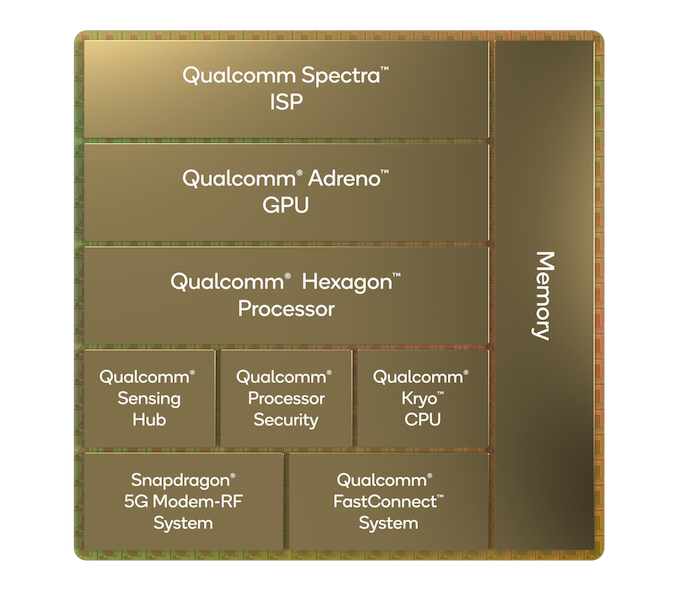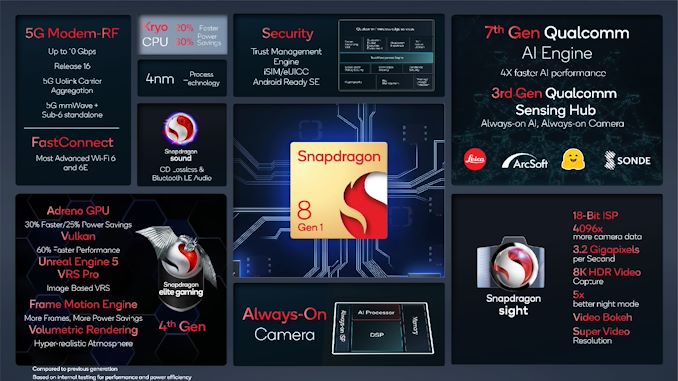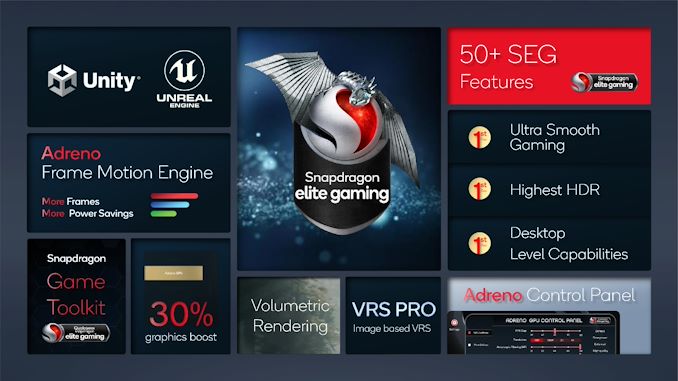Qualcomm Announces Snapdragon 8 Gen 1: Flagship SoC for 2022 Devices
by Andrei Frumusanu on November 30, 2021 6:00 PM EST
At this year’s Tech Summit from Hawaii, it’s time again for Qualcomm to unveil and detail the company’s most important launch of the year, showcasing the newest Snapdragon flagship SoC that will be powering our upcoming 2022 devices. Today, as the first of a few announcements at the event, Qualcomm is announcing the new Snapdragon 8 Gen 1, the direct follow-up to last year’s Snapdragon 888.
The Snapdragon 8 Gen 1 follows up its predecessors with a very obvious change in marketing and product naming, as the company is attempting to simplify its product naming and line-up. Still part of the “8 series”, meaning the highest end segment for devices, the 8 Gen 1 resets the previous three-digit naming scheme in favor of just a segment and generation number. For Qualcomm's flagship part this is pretty straightforward, but it remains to be seen what this means for the 7 and 6 series, both of which have upwards of several parts for each generation.
As for the Snapdragon 8 Gen 1, the new chip comes with a lot of new IP: We’re seeing the new trio of Armv9 Cortex CPU cores from Arm, a whole new next-generation Adreno GPU, a massively improved imaging pipeline with lots of new features, an upgraded Hexagon NPU/DSP, integrated X65 5G modem, and all manufactured on a newer Samsung 4nm process node.
The new chip promises large increases in performance and efficiency in a lot of the processing elements, as well as new features enabling new user experiences. Let’s start over the basic specifications and drill down the details that we have on the chip:
| Qualcomm Snapdragon Flagship SoCs 2020-2021 | |||
| SoC |
Snapdragon 8 Gen 1 |
Snapdragon 888 | |
| CPU | 1x Cortex-X2 @ 3.0GHz 1x1024KB pL2 3x Cortex-A710 @ 2.5GHz 3x512KB pL2 4x Cortex-A510 @ 1.80GHz 2x??KB sL2 6MB sL3 |
1x Cortex-X1 @ 2.84GHz 1x1024KB pL2 3x Cortex-A78 @ 2.42GHz 3x512KB pL2 4x Cortex-A55 @ 1.80GHz 4x128KB pL2 4MB sL3 |
|
| GPU | Adreno next-gen | Adreno 660 @ 840MHz | |
| DSP / NPU | Hexagon | Hexagon 780 26 TOPS AI (Total CPU+GPU+HVX+Tensor) |
|
| Memory Controller |
4x 16-bit CH @ 3200MHz LPDDR5 / 51.2GB/s 4MB system level cache |
||
| ISP/Camera | Triple 18-bit Spectra ISP 1x 200MP or 108MP with ZSL or 64+36MP with ZSL or 3x 36MP with ZSL 8K HDR video & 64MP burst capture |
Triple 14-bit Spectra 580 ISP 1x 200MP or 84MP with ZSL or 64+25MP with ZSL or 3x 28MP with ZSL 4K video & 64MP burst capture |
|
| Encode/ Decode |
8K30 / 4K120 10-bit H.265 Dolby Vision, HDR10+, HDR10, HLG 720p960 infinite recording |
||
| Integrated Modem | X65 integrated (5G NR Sub-6 + mmWave) DL = 10000 Mbps UL = 3000 Mbps |
X60 integrated (5G NR Sub-6 + mmWave) DL = 7500 Mbps UL = 3000 Mbps |
|
| Mfc. Process | Samsung 4nm (unspecified) |
Samsung 5nm (5LPE) |
|
CPUs: Cortex-X2 and Armv9 siblings
Starting off with the CPUs of the new Snapdragon 8 Gen 1 (I’ll shorthand it as S8g1 here and there): This is Qualcomm’s first chip featuring the new Armv9 generation of CPU IPs from Arm, which includes the Cortex-X2, Cortex-A710, and Cortex-A510 in a big, middle, and little setup. Qualcomm continues to use a 1+3+4 core count, a setup that’s been relatively successful for the designers over the past few years and iterations ever since the Snapdragon 855.
The Cortex-X2 core of the new chip clocks in at 3.0GHz, which is a tad higher than the 2.84GHz clock of the X1 core on the Snapdragon 888. This was actually a bit surprising to me, as I hadn’t expected much in the way of clock increases this generation, but it’s nice to see Arm vendors now routinely achieving this. For context, MediaTek’s recently announced Dimensity 9000 achieves 3.05GHz on its X2 core, however that’s on a TSMC N4 node. In contrast, Qualcomm manufactures the Snapdragon 8 Gen 1 on a Samsung 4nm node. The company wouldn’t confirm if it’s a 4LPE variant or something more custom, hence why we’re leaving it as a “4nm” node description in the specification table.
What is most surprising about the X2 core is that Qualcomm is claiming 20% faster performance or 30% power savings, the latter figure being especially intriguing. Samsung Foundry only describe a 16% reduction in power in going from a 5nm to 4nm node, and obviously 30% is significantly better than what the process node promises. We asked Qualcomm what kind of improvements lead to such a large power decrease; however, the company wouldn’t specify any details. I particularly asked if the new X2 cores have their own voltage domain (Previous Snapdragon 1+3 big+middle implementations shared the same voltage rail), but the company wouldn’t even confirm if this was the case or not. Arm had noted that the X2 can have quite lower power at the same peak performance point of the X1, if Qualcomm’s marketing materials refer to such a comparison, then the numbers might make sense.
The X2 core is configured with 1MB of L2 cache, while the three Cortex-X710 cores have 512KB each. The middle cores here are clocked slightly higher at 2.5GHz this year, a little 80MHz jump over the previous generation. Usually, the middle cores pay more attention to the power budget, so maybe this slightly increase does represent more accurately the process node improvements.
Lastly, the new chip also makes use of four Cortex-A510 cores at 1.8GHz. Unlike the Dimensity 9000 from a couple of weeks back, Qualcomm does make use of Arm’s new “merged-core” approach of the new microarchitecture, meaning that the chip actually has two Cortex-A510 complexes with two cores each, sharing a common NEON/SIMD pipeline and L2 cache. The merged core approach is meant to achieve better area efficiency. Qualcomm rationalized the approach by saying that in everyday use cases with fewer threads active and overall low activity, having a single core able to access a larger L2 cache shared by two cores can result in better performance and efficiency. Unfortunately even while making this comment, the company wouldn’t actually detail what the L2 size was, whether it’s 512KB or 256KB – if it’s the latter, then the configuration definitely isn’t as aggressive as the Dimensity 9000.
The new Armv9 CPU IPs from Arm also came with a new generation DSU (DynamiQ Shared Unit, the cluster IP) which the new Snapdragon makes use of. Qualcomm here opted for a 6MB L3 cache size, noting that this was a decision in balancing out system performance across target workloads.
As for system caches, Qualcomm mentioned that the chip remains unchanged with a 4MB cache, and the memory controllers are still 3200MHz LPDDR5 (4x 16bit channels). It’s to be noted that, as with last year’s Snapdragon 888, the CPUs no longer have access to the system cache, in order to improve DRAM latency. We can’t help but make comparisons to MediaTek’s Dimensity 9000, which likely will have worse DRAM latency, but also offer up to 14MB of shared caches to the CPUs versus just 6MB on the Snapdragon 8 Gen 1. How the two chips will compare to each other remains to be seen in actual commercial devices.
GPU: New Adreno architecture with no name
Back in the day, Qualcomm’s Adreno GPU architectures were easy to identify in terms of their family as well as performance levels. Particularly on the architecture side, the Adreno 600 series started off with the Adreno 630 in the Snapdragon 845 a few years ago, but unlike in previous iterations from the 400- and 500 series, we remained with that high-level description up until the Snapdragon 888 series.
The Snapdragon 8 Gen 1 here changes things, and frankly, Qualcomm did a quite horrible job at marketing what they have this time around. The new GPU name completely drops any model number, and as such doesn’t immediately divulge that it’s part of a larger microarchitecture shift that in the past would have been marketed as a new Adreno series.
Qualcomm notes that from an extremely high-level perspective, the new GPU might look similar to the previous generations, however there are large architectural changes included that are meant to improve performance and efficiency. Qualcomm gave examples such as concurrent processing optimizations that are meant to give large boosts in performance to real-world workloads that might not directly show up in benchmarks. Another example was that the GPU’s “GMEM” saw large changes this generation, such as an increase of 33% of the cache (to 4MB), and now being both a read & write cache rather than just a writeback cache for DRAM traffic optimizations.
The high-level performance claims are 30% faster peak performance, or 25% power reduction at the same performance as the Snapdragon 888. Qualcomm also uncharacteristically commented on the situation of peak power figures and the current situation in the market. Last year, Qualcomm rationalized the Snapdragon 888’s high peak GPU power figures by noting that this is what vendors had demanded in response to what we saw from other players, notably Apple, and that vendors would be able to achieve better thermal envelopes in their devices. Arguably, this strategy ended up as being quite disastrous and negative in terms of perception for Qualcomm, and I feel that in this year’s briefing we saw Quaclomm attempt to distance themselves more from the situation, largely by outright saying that the only point of such peak performance and power figures is for vendors to achieve higher first-run benchmarking numbers.
Unfortunately, unlike Apple, who actually use their GPU’s peak performance figures in transient compute workloads such as camera processing, currently the Android ecosystem just doesn’t make any advanced use of GPU compute. This admission was actually a breath of fresh air and insight into the situation, as it’s been something I’ve especially noted in our Kirin 9000, Snapdragon 888 and Exynos 2100 and Tensor deep-dives in criticizing all the new chips. It’s an incredibly stupid situation that, as long as the media continues to put weight on peak performance figures, won’t be resolved any time soon, as the chip vendors will have a hard time saying no to their customer’s requests to operate the silicon in this way.
Qualcomm states that one way to try to alleviate this new focus on peak performance is to change the way the GPU performance and power curve behaves. The team stated that they’ve gone in to change the architecture to try to flatten the curve, to not only achieve those arguably senseless peak figures, but actually focus on making larger improvements in the 3-5W power range, a range where the Snapdragon 888 last year didn’t significantly improve upon the Snapdragon 865.
That being said, even with a 25% decrease in power at similar Snapdragon 888 performance, the new Snapdragon 8 Gen 1 likely still won’t be able to compete against Apple’s A14 or A15 chips. MediaTek’s Dimensity 9000 also should also be notably more efficient than the new Snapdragon at equal performance levels given the claimed efficiency figures, so it still looks like Qualcomm’s choice of going with a Samsung process node, even this new 4nm one, won’t close the gap to the TSMC competitors.













219 Comments
View All Comments
vladx - Thursday, December 2, 2021 - link
Hardware supporting VVC hardware decode has already been announced while AV2 is still hasn't even been drafted:https://www.xda-developers.com/mediateks-pentonic-...
Just because you're ignorant about the current situation, doesn't mean everyone else is as well. At this rate, consumer hardware supporting encode will be released for VVC before AV1 let alone AV2.
vlad42 - Thursday, December 2, 2021 - link
And yet there has been no coverage. So right now, consumers are far more likely to know about AV1 and demand it than an unheard of VVC.Also, do you really think any company wants to pay VVC's license fees? The problems with licensing and royalties for HEVC is why it has taken so long for it to gain any adoption whatsoever. As of right now, there are at least two different groups selling the licenses needed for the patents - this is the same situation that caused HEVC to take 5 years before it was used by anyone in volume - remember HECV was released in 2013. H.264 had only one group you needed to by a license from and the total cost of the license was lower than HEVC's. The whole point of AV1 is that it is royalty free and does not have these problems.
As for you link, there is no indication of the setting used by AV1 or VVC. However, from what is known about AV1 it is clear they used it in fixed QP mode instead of VBR mode. It is well known that AV1 is optimized for VBR and that fixed QP is inefficient (it looses out to HEVC in all but UHD). However, with VBR it out performs HEVC in terms of bit rate savings by 20% at UHD. We would need proper thorough tests to be conducted to know if VVC's fees and performance costs would be worth it compared to AV1 (not to mention that AV1 could be further improved much like HEVC was during it's lifetime and VVC undoubtedly will be).
Just because you're ignorant about the current situation, doesn't mean everyone else is as well. Hardware AV1 encoders were announced back in 2019.
On 18 April 2019, Allegro DVT announced the AL-E210 with hardware AV1 encoding support for main 0 at 4K30 at 10-bit. In addition the Allegro AL-E195 has hardware AV1 encoding support for main 0 and professional 1 and Chips&Media's WAVE627 has hardware AV1 encoding support for main 0 at up to 4K120.
Just because your going to act like a know-it-all jackass does not mean you actually know anything at all.
vladx - Thursday, December 2, 2021 - link
"Also, do you really think any company wants to pay VVC's license fees?"Umm yes? The cost savings from lower bandwidth usage provided by VVC's superior compression beats any royalties. No one besides Google and cheapskates like Mozilla minds paying royalties for the best codec around.
vlad42 - Friday, December 3, 2021 - link
If this were the case, then there would have been rapid adoption of HEVC across the board - especially among the likes of Twitch, YouTube, Netflix, Amazon Prime, etc. Instead we find that Twitch relies solely upon h.264, YouTube re-encodes as much as possible (everything?) to VP9 and h.254, and Netfix and Amazon Prime use h.264 for everything except UHD, etc.The licensing/royalty fiasco for HEVC is the largest reason why HEVC adoption has be pathetic compared to h.264. So yes, if VVC's licensing fees are anything like HEVC's, then these companies will not care about superior compression, AV1 with VBR will be good enough. It is not just Google and "cheapskates" like Mozilla.
vlad42 - Friday, December 3, 2021 - link
Damn lack of an edit button...that should be VP9 and h.264 not h.254vladx - Friday, December 3, 2021 - link
Both Netflix and Amazon Prime have been using HEVC for ages, Twitch uses H.264 because they want as many streamers as possible and there are still plenty with pre-2015 PCs who try their hand at streaming on their shitty computers.vlad42 - Monday, December 6, 2021 - link
And as I said only for 4K content. If it was really worthwhile, they would use it for everything. However they do not.Also, if Twitch wants to maximize their user base, then why go straight to AV1 and not go to HEVC? Surely more viewers have hardware decode/encode support for HEVC than AV1? The only logical explanation is that their are licensing problems/the fees are too high.
mode_13h - Saturday, December 4, 2021 - link
> Instead we find that Twitch relies solely upon h.264It seems to me that Twitch would use whatever is the lowest common denominator of its users, both in terms of their decoding & encoding capabilities. And when encoding, not only the capability matters but also how much overhead it adds, which could potentially impact gameplay.
vlad42 - Monday, December 6, 2021 - link
If Twitch wants to maximize their user base, then why go straight to AV1 and not go to HEVC? Surely more viewers have hardware decode/encode support for HEVC than AV1? The only logical explanation is that their are licensing problems/the fees are too high.name99 - Thursday, December 2, 2021 - link
In what sense are these IP blocks "consumer hardware"?I'd say a reasonable proxy for consumer hardware is "is present in some phones". Can that be said for AV1?
You can compare the uptake for AV1 with HEVC. I'd say there's a notable difference...
Especially important is HW encoders. Decoders are easy, but you need encoders in phones to get a real change in usage.
https://en.wikipedia.org/wiki/AV1#Adoption
https://en.wikipedia.org/wiki/High_Efficiency_Vide...